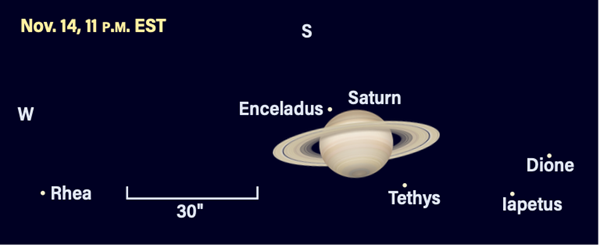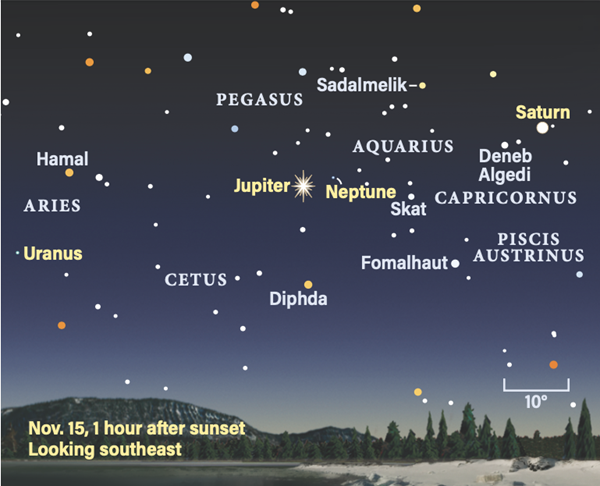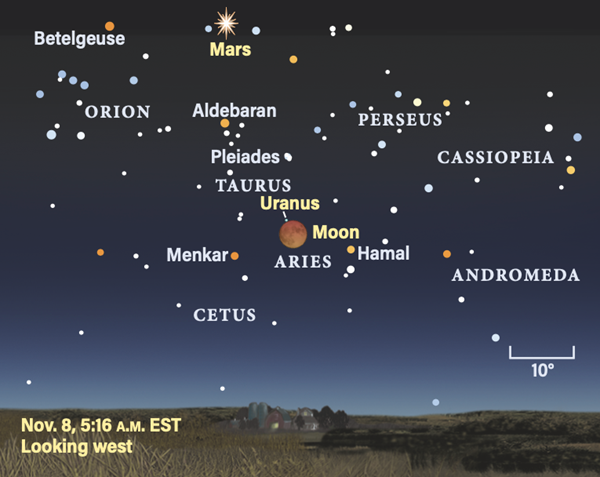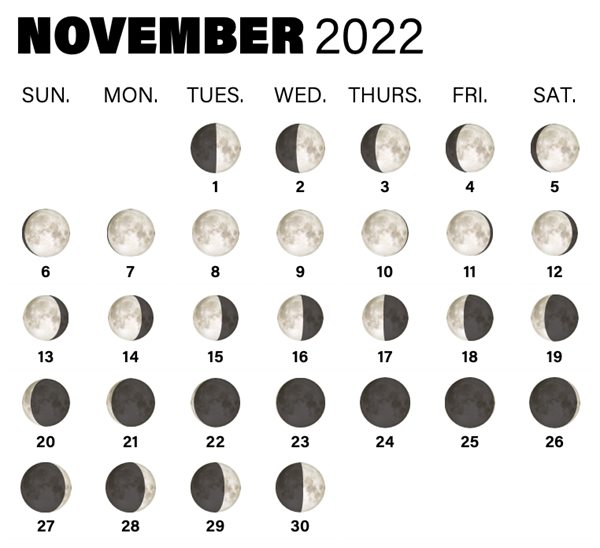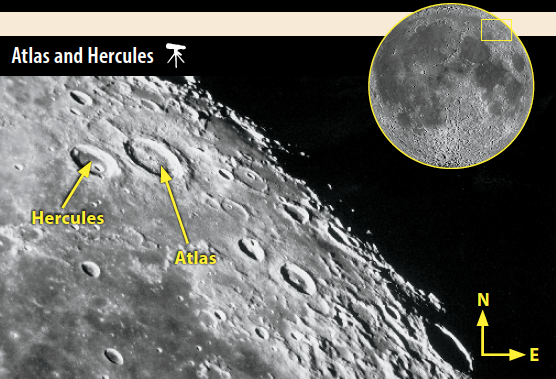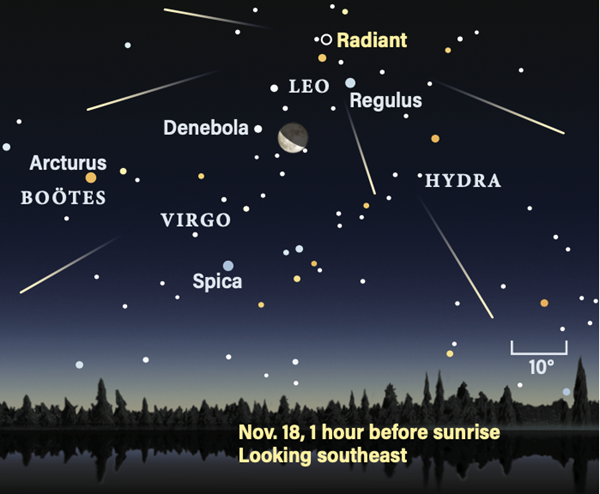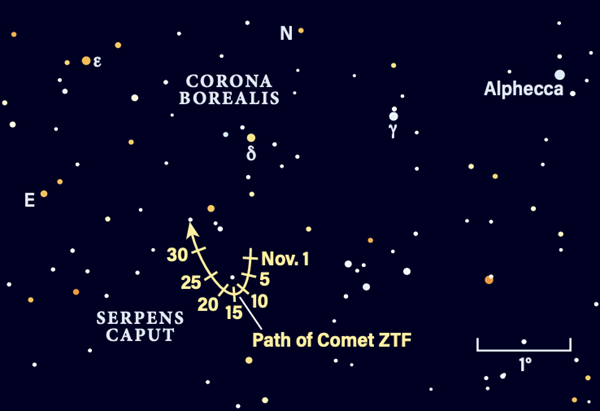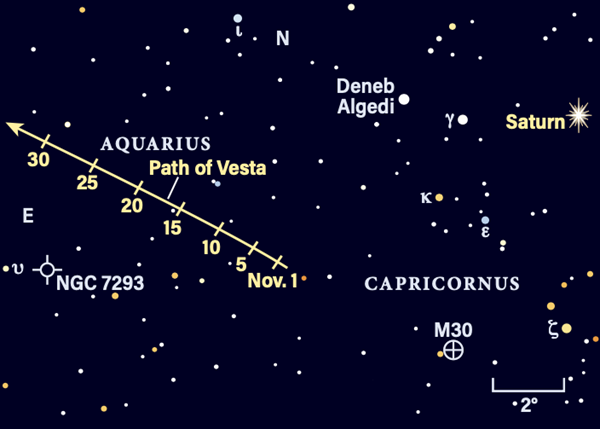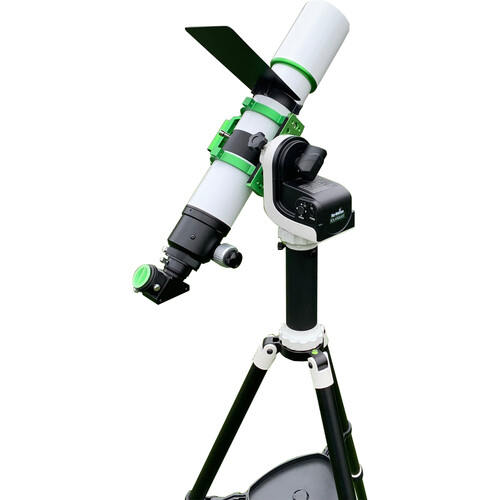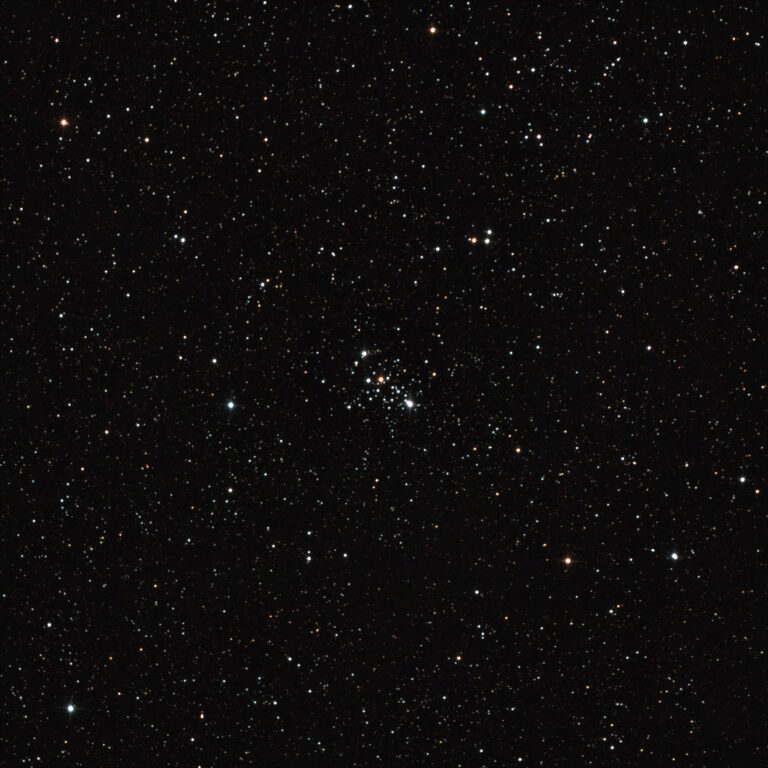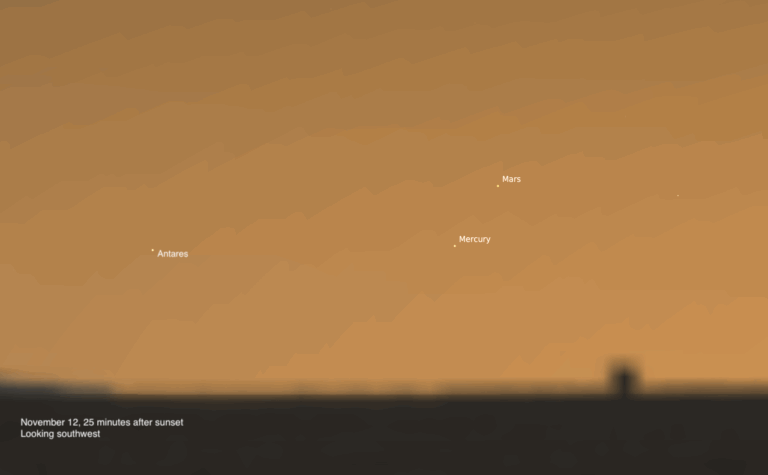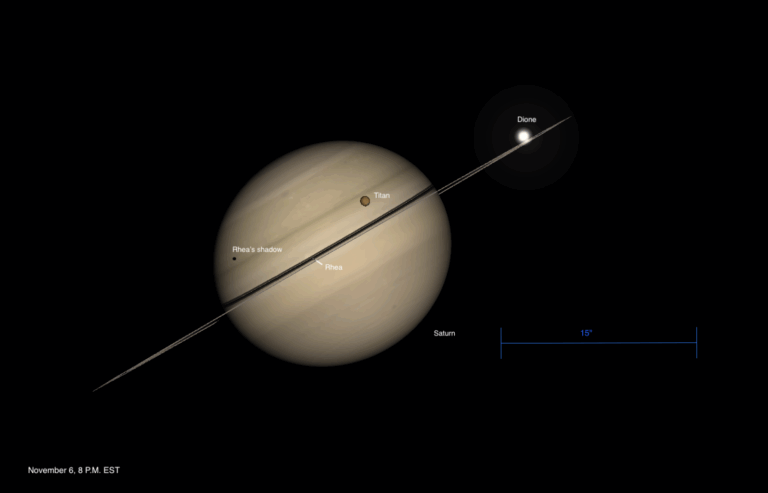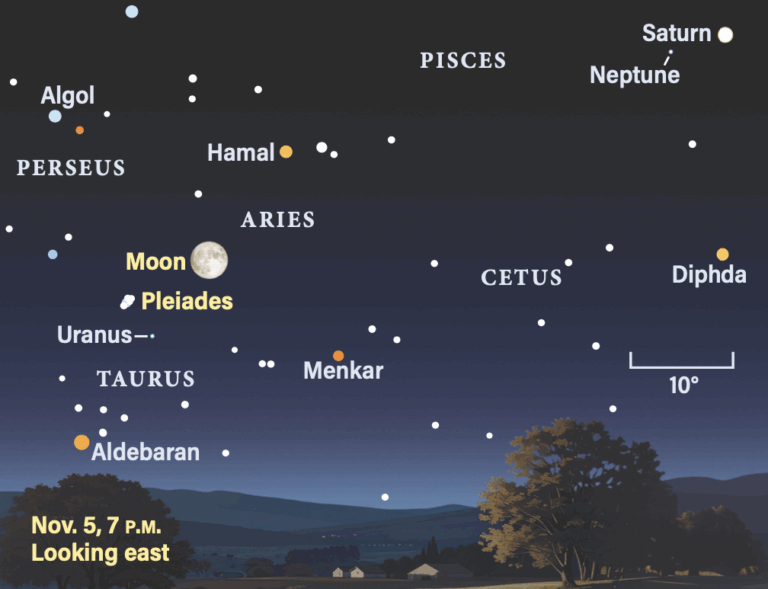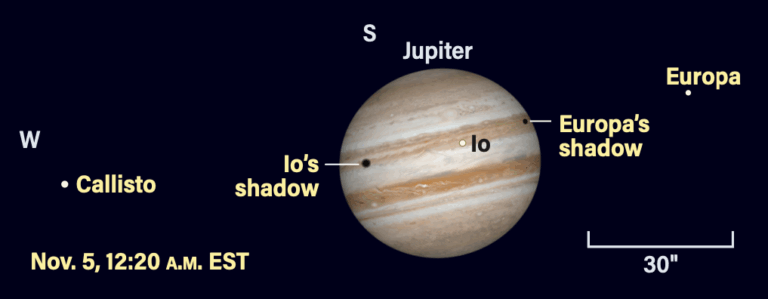Key Takeaways:
An outer-planet bonanza is in store this month. Saturn never fails to deliver and is visible in the early evening. Jupiter offers up stunning views, along with a nice series of repeating Europa and Ganymede transits. The distant giants Uranus and Neptune are easy to star-hop to for intriguing sights. And finally, there’s Mars, high in Taurus after midnight in the most favorable apparition in years for Northern Hemisphere observers. It’s closing in rapidly for an early December opposition, yet is closest to Earth on the last day of this month.
The ringed planet Saturn lies low (35°) in the southern sky and is best viewed soon after dark. As November opens, Saturn stands 5° north of a First Quarter Moon, both located in eastern Capricornus the Sea Goat. A waxing crescent returns to the same area Nov. 28. The planet sets about 10:30 P.M. local time in late November.
Saturn glows at magnitude 0.6 and dims 0.1 magnitude during the month. Telescopic views show the rings well, spanning 38″. Their apparent tilt to our line of sight is 15°, with their northern face sunlit; they’ll appear edge-on by 2025.
Titan, Saturn’s largest moon, is magnitude 8.5 — an easy target for small telescopes. You’ll find it north of Saturn Nov. 8/9 and 24/25, and due south Nov. 16. Tethys, Dione, and Rhea, all magnitude 10, orbit closer and change relative locations from night to night.
Iapetus normally resides far east or west of Saturn, often outside a field of view containing the planet. It can be hard to find, but in mid-November, it’s lined up nicely with Saturn and visible in the same field of view.
On Nov. 13, Iapetus passes through superior conjunction on the far side of its orbit, placing it just north of the disk. It stands 12″ from the center of Saturn, or about 5″ from the northern limb of the planet. At 11th magnitude, it’s a challenging object, given the brilliance of Saturn. Check the night before or the night after, when Iapetus stands 46″ northwest or 35″ northeast of the disk, respectively. On the 14th, Dione shows the way to Iapetus to its northwest, the fainter moon within 10″ of its brighter sibling. As Iapetus moves farther east, it fades to 12th magnitude as its darker hemisphere turns earthward.
Look for Neptune about 6.5° west-southwest of Jupiter, due south of the Circlet of Pisces. You can spot the magnitude 7.7 planet with binoculars. It’s placed conveniently between two brighter 7th-magnitude stars all month, aiding its identification, and remains visible until after midnight. The two stars are the easternmost pair of a parallelogram of four stars each about 1° apart, located 5° east-northeast of Phi (ϕ) Aquarii. Check the nightly progress of Neptune within this grouping. The ice giant’s retrograde path carries it from near the northeastern star to a point almost due north of the southwestern star by the end of November, when Neptune slows just prior to next month’s stationary point. A telescope reveals its dim bluish disk, spanning 2″. A bright gibbous Moon lies 5° southwest of Neptune Nov. 3/4.
Jupiter is up all evening and is best viewed right after dark, when it is high in the southern sky in Pisces. On Nov. 4, a bright gibbous Moon stands 3° southeast of Jupiter. The planet shines at magnitude –2.8 and dips by 0.2 magnitude during the month. It halts its retrograde motion Nov. 24, then resumes moving east.
A telescopic view is one of the season’s highlights, with a wealth of detail visible on the 47″-wide disk. During November, Jupiter shrinks slightly to 44″ as the planet’s distance from Earth increases. The belts straddling the equator are obvious in any scope; features such as subtle wisps of clouds and spots move noticeably in minutes, thanks to Jupiter’s rapid rotation. Watch for the occasional appearance of the Great Red Spot and check out the wandering Galilean moons.
These moons regularly transit the face of Jupiter, casting their accompanying shadows. November opens with a few nicely timed evening transits. As night falls on Nov. 1, Io and its shadow are drifting in front of the planet, with the moon leading. Around 9 P.M. EDT, the pair straddles the central meridian. Io exits at 9:50 P.M. EDT, followed by its shadow 53 minutes later.
On Nov. 2, Ganymede’s giant shadow begins a transit shortly before Europa’s shadow exits. Ganymede’s shadow moves onto the disk at 8:22 P.M. EDT, taking several minutes to appear. Europa’s shadow leaves the disk at 9:00 P.M. EDT. Ganymede’s shadow spends nearly three hours crossing the cloud tops, visible most of the evening in the U.S.
On Nov. 9 (note daylight saving time ends Nov. 6), Europa is on the disk at nightfall on the East Coast and Ganymede begins to transit at 7:15 P.M. EST. Europa’s shadow transit starts at 8:06 P.M. EST and the moon exits the disk 30 minutes later. Ganymede treks across Jupiter together with Europa’s shadow, the moon exiting at 10:03 P.M. EST, while the shadow transit ends 32 minutes later. The sequence repeats Nov. 16/17 with the events spaced farther apart, and again Nov. 23/24.
No transits involving Callisto occur for the rest of 2022. Callisto appears due north of Jupiter the morning of Nov. 2 and early in the evening on Nov. 18, and due south Nov. 27.
Uranus in southern Aries is an easy binocular target at magnitude 5.7. It lies about 7° north-northeast of Mu (μ) Ceti. North of Mu, look for 5th-magnitude Sigma (σ) Arietis, then Rho (ρ) Arietis 3° farther along the same line. Uranus’ bluish disk spends the month roughly midway between these two stars. It’s visible all night and is highest in the sky in the hour before local midnight. The ice giant reaches opposition early on the 9th.
Uranus makes a close appulse to a 7th-magnitude field star Nov. 18 and 19. Late on the 18th, the planet stands less than 1′ due north of the star. The following night, it is 2′ due west of the star. Through a telescope under good conditions, Uranus reveals a 4″-wide disk. This distant world looks tiny from Earth, yet it is nearly five times larger. It lies more than 1.7 billion miles from Earth.
Mars continues its spectacular run across Taurus, nearing next month’s opposition. On Nov. 1, it shines at magnitude –1.2 about 17° north of Betelgeuse. Mars rises soon after 8 P.M. local time and stands near the horns of the Bull. It has just begun its retrograde path, moving westward and meeting a gibbous Moon Nov. 10, when Mars shines with the same brilliance as Sirius. Do you think they look equally bright? Their color difference will affect your impression. By the end of the month, Mars brightens to a stunning magnitude –1.8.
On Nov. 1, Mars stands due south around 3 A.M. local time. By Nov. 30, it’s due south by midnight and also rises nearly two hours earlier than at the beginning of the month.
Now is the time to catch Mars near its best. It’s not as close to Earth as the previous opposition, but is at a much higher altitude after midnight, benefiting Northern Hemisphere observers. Through a telescope, Mars spans 15″ on Nov. 1 and grows to 17″ by Nov. 30. Early in the month, its phase is a noticeable 94 percent; it reaches 99 percent three weeks later. Mars comes closest to Earth the night of Nov. 30, when it is 50.6 million miles away.
Now that you’ve spent months perfecting your observing techniques, it’s time to take advantage. Both polar regions are on view this month as the planet’s tilt with respect to Earth reaches 0° on Nov. 8. The Red Planet’s rotation period is some 40 minutes longer than Earth’s, so if you observe at the same time each night, Mars appears to rotate backward by about 10°. You can adjust your observing time to catch the features listed here. In the hours around local midnight, the following features are facing Earth (for the Midwest): Nov. 1 – Mare Sirenum; Nov. 10 – Olympus Mons and the Tharsis Ridge; Nov. 17 – Tharsis Ridge and Valles Marineris; Nov. 23 – Valles Marineris to Sinus Meridiani; Nov. 30 – Syrtis Major and Hellas. Check a map of Mars for other nearby features and enjoy becoming familiar with them as we approach next month’s opposition.
Mercury passes through superior conjunction with the Sun Nov. 8. Venus is just over a week past superior conjunction as November opens and, like Mercury, remains too close to the Sun for observation.
The second total lunar eclipse of the year takes place early on Nov. 8 in the U.S. Like May’s eclipse, it lasts 85 minutes, but this time occurs at the ascending node of the lunar orbit, crossing the ecliptic from south to north. Parts of Europe, the Middle East, Asia, and Australia also get varying views.
In the U.S., the eclipsed Moon is setting across the eastern seaboard; the eastern half of the country sees morning twilight affecting the later stages of totality. Following the faintly visible penumbral stage, the dark umbra appears at 4:09 A.M. EST. It takes an hour for the Moon to reach totality, which begins at 5:16 A.M. EST. The Midwest and western half of the country enjoy most of totality in darkness. Mid-totality occurs at 5:59 A.M. EST. The Pleiades (M45) sparkle above the eclipsed Moon, while Orion stands high in the southwest. On the East Coast, the Moon sets soon after the end of totality (which occurs at 6:41 A.M. EST). The remaining stages proceed in brightening twilight in the Midwest; the partial phase ends at 7:49 A.M. EST.
The eclipse occurs near the location of Uranus in Aries. At the onset of totality, Uranus stands 1.9° east of the lunar limb, easily within the field of view of binoculars. For observers in northwestern Canada, Alaska, and eastern Asia, Uranus is occulted by the Moon around the end of the partial phase. Watch for any other faint stars that are occulted during the eclipse and look out for early Leonid meteors as well. For more details about the eclipse, see “Totality touches the Moon” on page 25 of the November 2022 issue.
Rising Moon: Highlights in the highlands
The great rayed crater Tycho is the attention-getter near Full phase, and rightfully so. But two of its smaller cousins dominate the southeast limb. Because the impacts are young — relatively speaking — their bright ejecta blankets and rays have not had time to darken under the weak but relentless sandblasting from particles blown on the solar wind.
Any time during November’s first week, zoom in to separate the double source of these white rays. Punching up the power also helps to tone down the glare. Stevinus A is brighter and slightly smaller than Furnerius A, which lies closer to the limb. The duo straddles the modest 40-mile-wide crater Stevinus, which is barely noticeable under the high Sun. Topographic features in the lunar highlands are easier to spot under a lower Sun, which occurred in the final week of last month. Shadows also abound on Nov. 9th, just before their long lunar night. The pair of bright rays reappears on the 29th.
There are a couple of ways to reduce the brightness of the Moon if you don’t have a filter. Put on your sunglasses — most low-power eyepieces have enough eye relief to let you wear your shades. Alternatively, reduce the aperture by using a mask with a 3-inch hole, or tape a piece of cardboard to cover half or more of the front of your scope — the shape doesn’t matter that much.
Meteor Watch: Chancy prospects
A waning crescent Moon affects the annual Leonid meteor shower, which peaks late on Nov. 17 (catch the radiant rising early on Nov. 18). The shower is active from Nov. 6 to 30. The bright Moon will render fainter members invisible, effectively dropping the expected zenithal hourly rate of 10 to 15 to low single digits. (Some predictions do anticipate a potential outburst Nov. 19 — see “The Leonids promise to dazzle this year” on page 16.)
The brighter members are spectacular and worth spending a few hours under a clear morning sky to catch. Many come with persistent trains, particularly near dawn, when their closing velocity is higher. Leo rises soon after midnight and the radiant is 70° high for mid-northern latitudes in the hour before dawn.
Comet Search: Preparing for launch
My mind is racing in anticipation of seeing unaided a comet scoot under Polaris and above a sweeping auroral curtain at the end of January. Discovered in March 2022 by the Zwicky Transient Facility, Comet C/2022 E3 (ZTF) is expected to peak at 5th magnitude in February.
The Moon leaves the evening sky midmonth, when you can head out for a direct look. Now glowing around 10th magnitude, ZTF will need a 6-inch scope above 100x to deliver some structure. The south flank should be well defined, thanks to the solar wind pushing ejected dust outward. A short fan spreads northward, ending sharply to the west, where imagers may pick up a blue ion tail. The intensifying radiation from the Sun should trigger a green halo from diatomic carbon as November comes to a close.
ZTF appears to be executing a slow hairpin turn just left (east) of Corona Borealis. Its true path is a parabola, like all dirty snowballs originating at the edge of the Oort Cloud. By chance this month, Earth’s motion is briefly parallel to the comet’s, making it appear to hover in one area. When we pass underneath it in January, ZTF will cross half the sky in a few nights!
Locating Asteroids: In deep water
Spying the second-largest asteroid in our solar system won’t be quite as easy as it was last month. Plying the mythological border waters of Aquarius and Capricornus, 4 Vesta drifts halfway between Saturn and the southern beacon Fomalhaut in Piscis Austrinus. Fortunately, our target remains reasonably bright at magnitude 7.6 — it’s just a little isolated for the star-hopping crew, who will need to execute some well-planned tacks.
Vesta hits its high point in the south, called culmination, around 8 P.M. local time. Don’t wait to let it sail down behind trees and buildings. Avoid the first and last few days of the month, when the glare from the nearby Moon interferes. With an albedo of 0.38, Vesta’s reflected sunlight outshines most of the background stars here. You can easily see it shift against them from the 4th to the 5th, the 15th to the 17th, and the 27th to the 28th.
Heinrich Olbers first detected Vesta’s movement in 1807, making it the 4th asteroid to be discovered. But back then, it was categorized as a planet.


